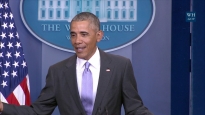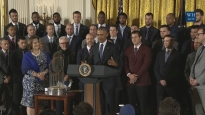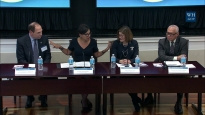Ruby Bridges visits with the President and her portrait
July 15, 2011 | 1:37 | Public Domain
Ruby Bridges visited the White House to see how a painting commemorating her personal and historic milestone looks hanging on the wall outside of the Oval Office. American Artist Norman Rockwell was criticized by some when this painting first appeared on the cover of Look magazine on January 14,1964; now the iconic portrait will be on display throughout the summer of 2011 in one of the most exalted locations in the country.
President Obama Meets Civil Rights Icon Ruby Bridges
Watch the video of President Obama and Ruby Bridges here.
When Ruby Bridges visited the Oval Office on July 15, President Obama told her, "I think it's fair to say that if it wasn't for you guys, I wouldn't be here today."
November 14, 2010 marked the 50th anniversary of six-year-old Ruby's history-changing walk to the William Franz Public School in New Orleans as part of court-ordered integration in 1960. Six years after the 1954 United States Supreme Court ruling in Brown v. Board of Education declared that state laws establishing separate public schools for black and white students were unconstitutional, this event represented a victory for the American Civil Rights Movement.
Bridges was at the White House to see how a painting commemorating this personal and historic milestone looks hanging on the wall outside of the Oval Office. American artist Norman Rockwell was criticized by some when this painting first appeared on the cover of Look magazine on January 14,1964; now the iconic portrait will be on display throughout the summer of 2011 in one of the most exalted locations in the country.
The President likes pictures that tell a story and this painting fits that bill. Norman Rockwell was a longtime supporter of the goals of equality and tolerance. In his early career, editorial policies governed the placement of minorities in his illustrations (restricting them to service industry positions only). However, in 1963 Rockwell confronted the issue of prejudice head-on with this, one of his most powerful paintings. Inspired by the story of Ruby Bridges and school integration, the image featured a young African-American girl being escorted to school by four U.S. marshals amidst signs of protest and fearful ignorance. The painting ushered in a new era in Rockwell’s career and remains an important national symbol of the struggle for racial equality.
Rockwell received letters of both praise and criticism from Look readers unused to such direct social commentary from the illustrator. Rockwell would revisit the theme of civil rights in several other illustrations from the period.
Ruby Bridges Hall now serves on the board of Norman Rockwell Museum and founded The Ruby Bridges Foundation in 1999 to promote the values of tolerance, respect, and appreciation of all differences. She commended Rockwell for having “enough courage to step up to the plate and say I’m going to make a statement, and he did it in a very powerful way.”
Special thanks to the Norman Rockwell Museum for providing the biographical information on the artist and this painting.
|
January 18, 2017
|
January 17, 2017
|
January 16, 2017
|
January 16, 2017
|
|
January 14, 2017
|
January 13, 2017
|
January 13, 2017
|
January 12, 2017
|







